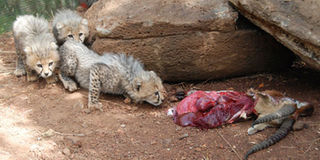KWS, conservancy fight over cheetahs

Photo/CORRESPONDENT | NATION
One of three cheetah cubs over whose custody the KWS and Mara Conservancy are fighting sniffs an impala carcass at the conservancy.
On the morning of March 1 a mother cheetah gracefully wandered into the lush golden savannah grassland of the western tip of the Maasai Mara Game Reserve with her three two-month-old cubs.
Pulled by the craving for food, she left them behind and hunted deep into lion territory. She never returned. It is possible she fell into the jaws of the lions.
A search by game rangers found only the destitute cubs, now shrivelled due to hunger and cold. They were transferred to the Mara Triangle headquarters.
A tussle
But the little cubs are now the subject of a dispute between the Kenya Wildlife Service and the Mara Conservancy, which manages the Mara Triangle on behalf of the Trans Mara County Council.
The triangle, known for its rich wildlife, was hived off the Narok County Council side of the world-famous reserve when Trans Mara district was carved out of the larger Narok district in 1994.
It is a centre of attraction for tourists who flock there to watch the wildebeest migration. It is also home to hippo, lions, cheetah and rhino.
While the conservancy wants to keep the cubs, KWS on Saturday moved them to the Animal Orphanage in Nairobi. Each party seemed eager to take care of the cubs, the contest being the best way to do so.
The conservancy wants to keep the cubs, arguing that they would find a better habitat in the Mara than being kept “in captivity at the Nairobi Animal Orphanage.”
“These cubs play an important role in the survival of their species. We are appealing to the Kenyan Wildlife Service to give these cheetahs a chance due to the critical situation.
“Everything is in place, the cubs are wild, experts in carnivore release have stepped up to help, everything is ready except the cooperation of the KWS,” said Ms Sybelle Foxcroft, wildlife biologist and cat specialist, who is also the founder of an Australian Conservation organisation Cee4life.
But KWS director Julius Kipng’etich says all wildlife are the property of the State and that it could not give licence to own an orphanage without a sustainability model.
The cheetah has lost 76 per cent of its historical range and has continued to be threatened by habitat loss, competition by rival carnivores and persecution by farmers. It is estimated that there are just about 300 cheetahs left in the Maasai Mara.
“The proposal for rehabilitation for the three cubs was sent to KWS on May 5, 2012. On the May 7 Kenya Wildlife Service informed MC that the proposal will apply for future incidents and not for the current three cubs,” the conservancy said in a statement.
Dr Kipng’etich told the conservancy in a letter that cheetah rehabilitation back to the wild is not scientifically proven to be successful, and the cheetahs would be kept at the orphanage for educational purposes.
In the last two years, there has not been a single surviving cheetah cub in the Mara Triangle. A total of 16 cubs have been killed by hyenas, leopard and tawny eagles.
The conservancy started a social media campaign mobilising animal lovers to join them in lobbying KWS to allow the cubs to enjoy their freedom.
But on Saturday, Mr Kipng’etich was adamant the animals had to be moved.




